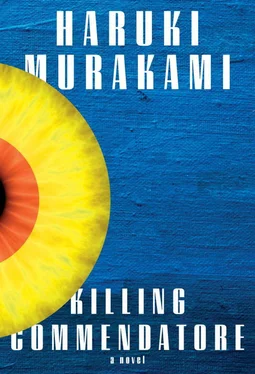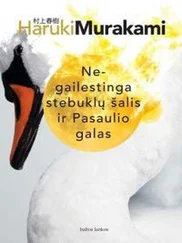I shifted the phone to my left hand and scratched behind my right ear.
The agent went on. “The person saw several portraits you’ve done and was very impressed. He felt that the vitality in your paintings can’t easily be found elsewhere.”
“I don’t get it. How could an ordinary person have seen several of my portraits? It’s not like I have a one-man show at a gallery every year.”
“I really don’t know the details,” he said, sounding perplexed. “I’m just passing along what the other party told me. I told him up front that you were no longer doing portraits. I said you seemed pretty firm about it, and even if I asked you you’d most likely turn him down. But he wouldn’t give up. That’s when this figure came up.”
I mulled over the offer. Honestly, it was a tempting amount. And I felt a bit of pride that someone saw that much value in my paintings—even if it was work I’d done half mechanically for money. But the thing was, I’d sworn I’d never paint commissioned portraits again. When my wife left me it spurred me to start over again, and I couldn’t reverse my decision just because somebody was willing to shell out a pile of money.
“Why is he being so generous?” I asked.
“Even though we’re in a recession, there are still people who have so much money they don’t know what to do with it. There are a lot of people like that—ones who made a killing in online stock trading, or tech entrepreneurs. And getting a portrait done is something they can write off as a business expense.”
“Write off?”
“In their accounts a portrait isn’t included as a work of art but as office equipment.”
“Talk about heartwarming,” I said.
But even if they have tons of excess cash, and even if they can write it off as a business expense, I can’t see entrepreneurs or people who’ve made a fortune trading stocks online wanting to have their portraits painted and hung on their company walls as office equipment . Most of these are young people decked out at work in faded jeans, sneakers, worn T-shirts, and Banana Republic jackets, proud to be drinking Starbucks from a paper cup. An imposing oil portrait didn’t fit their lifestyle. But there are all kinds in the world. You can’t generalize. It’s not necessarily true that no one wants to be painted sipping Starbucks (or whatever) coffee (Fair Trade beans only, of course) from a paper cup.
“But there’s one condition,” the agent said. “The other party wants you to use the client as a live model, and paint when you’re actually together. They’ll make the time to do that.”
“But I don’t work that way.”
“I know. You meet the client but don’t have them model for you. That’s your way of working. I told them that. They said they understood but they’d like you to make an exception and paint the client live and in person. That’s the other party’s condition.”
“What’s the purpose?”
“I don’t know.”
“That’s a pretty odd request. Why would they insist on that? You’d think they’d be happy not to actually have to sit for the portrait.”
“I agree it’s unconventional. But it’s hard to complain about the fee.”
“I’m with you there—hard to complain about the fee,” I agreed.
“It’s all up to you. It’s not like you’re being asked to sell your soul or anything. You’re a very skilled portrait painter, and they’re counting on that skill.”
“I feel like a retired hit man in the mob,” I said. “Like I’m being asked to whack one more target.”
“Though no blood’s going to be shed. What do you say—will you do it?”
No blood’s going to be shed , I silently repeated. The painting Killing Commendatore came to mind.
“What sort of person is the one I’d paint?” I asked.
“Actually, I don’t know.”
“You don’t even know if it’s a man or a woman?”
“I don’t. I haven’t heard a thing about the sex or age or name. At this point he’s a totally faceless client. A lawyer saying he was representing the client called me. That’s the ‘other party’ I spoke with about it.”
“Do you think it’s legit?”
“I don’t see anything suspect about it. The lawyer works at a reputable firm and said they’ll transfer an advance as soon as you accept.”
Phone in hand, I sighed. “This is kind of sudden, and I don’t think I can give you an answer right away. I need time to think.”
“Understood. Think about it as long as you need. It’s not an urgent job, the other party said.”
I thanked him and hung up. I couldn’t think of anything else to do so I went to the studio, turned on the light, plunked myself down on the floor, and stared vaguely at Killing Commendatore . After a while I started to get hungry and went to the kitchen, piled a plate with Ritz Crackers and ketchup, and went back to the studio. I dipped the crackers in the ketchup and munched them as I went back to staring at the painting. Nothing about that food tasted good. It was, if anything, pretty awful. But taste wasn’t the issue. Keeping hunger at bay for a while was the priority.
That’s how much the painting drew me in, from the overall composition to the small details. It truly held me captive. After a few weeks of exhaustive gazing at the painting, I ventured closer to it to inspect each detail. What most caught my attention were the expressions on each of the five people’s faces. I did minute pencil sketches of each of them. From the Commendatore, to Don Giovanni, Donna Anna, Leporello, and Long Face. Just like a reader might carefully copy down in a notebook each word and phrase he liked in a book.
This was the first time I’d ever sketched figures from a Japanese-style painting, and it was far more difficult than I’d expected. Japanese painting emphasized lines, and tended to be more flat than three-dimensional. Symbolism was emphasized over reality. It’s inherently impossible to transfer a painting done from that perspective into the grammar of Western painting, though after much trial and error I was able to do a fairly decent job of it. Calling it “recasting” might be a bit much , but it was necessary to interpret and translate the painting in my own way. Which necessitated grasping the intent that went into the original painting. I had to come to an understanding of Tomohiko Amada, his viewpoint as an artist, and the kind of person he was. Figuratively speaking, I had to put myself in his shoes.
After I’d done this for a while, the thought struck me: maybe doing a portrait again wasn’t such a bad idea. I mean, my painting wasn’t going anywhere. I couldn’t even get a hint of what I should paint, or what I wanted to paint. Even if I wasn’t too keen on the job, getting my hands moving again wouldn’t be a bad thing. If I kept on like this, unable to draw a thing, I might find myself unable to paint ever again. Maybe I wouldn’t even be able to paint a portrait. The fee, of course, was also pretty tempting. My living expenses at this point were minimal, but my pay from the art classes wasn’t enough to cover them. I’d gone on that long trip, bought a used Corolla station wagon, and my savings were diminishing. So a sizable fee like the one I’d get from doing the portrait was, admittedly, very appealing.
I called my agent and told him that just this one time, I would take on the job. Naturally, he was happy to hear this.
“But if I have to paint the client in person, that means I need to travel to wherever he is,” I said.
“No need to worry about that. The other party will come to your place in Odawara.”
“To Odawara?”
“That’s right.”
“He knows where I’m living?”
“He apparently lives nearby. He even knows that you’re living in Tomohiko Amada’s place.”
Читать дальше











